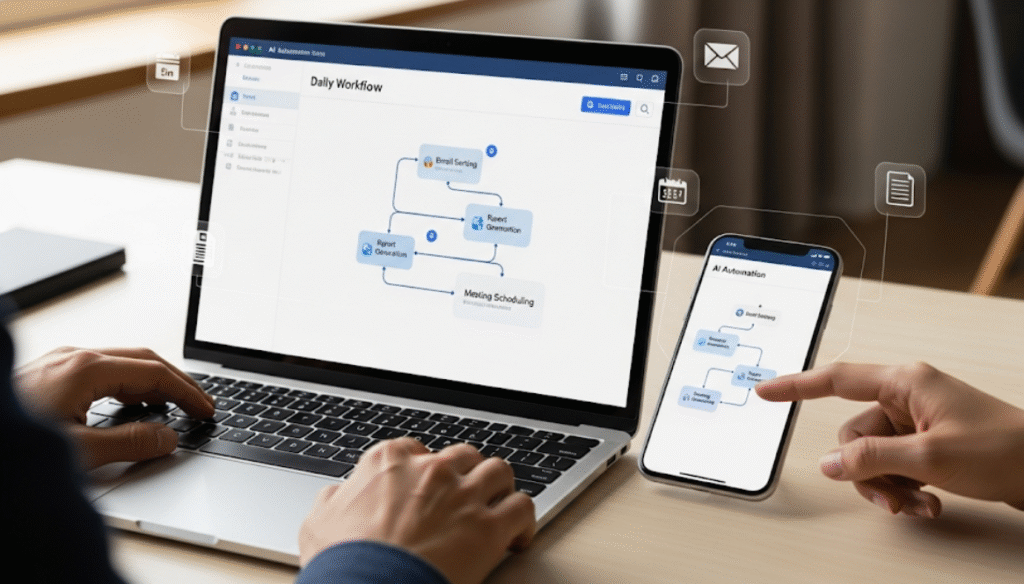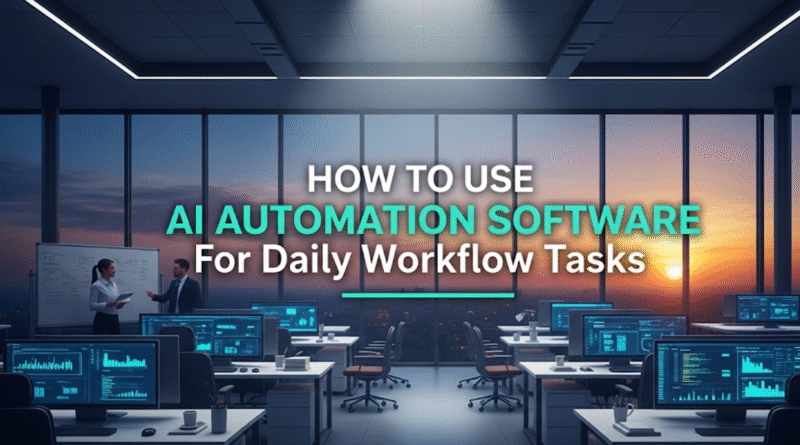How to Use AI Automation Software for Daily Workflow Tasks
Now… imagine showing up to work with your coffee in hand and instead of knocking out a mountain of repetitive tasks, you see them get done on their own with the help of your computer… Then, email responses are written, data is sifted through and reports are created — all without you even having to break a sweat. Sounds like science fiction, but in fact it is just the reality of AI automation software that is changing the way we work today.
Automation tools in AI have proven a game-changer for all business persons who want to automate the data process and get rid of manual work. In a smart system, these are the tasks that can be automated away — either by using recipes to allow decisions to be made on data or just removing the need for it completely: Whether you are a small business owner, corporate worker or freelance operator, AI automation can improve your life.
The Importance of AI Automation in Today’s Business Environment
The average office worker spends nearly 40% of their time on mundane, repetitive admin tasks that could easily be done by software. That is roughly 2 full workdays per week that are used on repetitive tasks and non-human dependent tasks (i.e. running overnight processes). To win this challenge, the AI automation software helps replicate people in the process and allows human only to do strategic work, he added.
Companies utilizing AI automation claim record improvement in efficiency, accuracy, and the morale of employees. This means deskless workers can spend less time on boring, repetitive tasks and more time on creative problem-solving, customer interaction and innovation. From basic rule-based systems, the technology has advanced to complex platforms capable of adjusting and learning from user behavior.
How to Use AI Automation Tools
Pick the Perfect Platform For You
Choose software that is right for you before going into automation. Popular platforms include:
- Zapier: Lets you connect two different apps and automate workflow between them
- Power Automate (formerly called Microsoft Flow): Fits well with Microsoft Office products
- IFTTT (If This Then That): An easy way to do business and personal automation
- UiPath: It is a next level automation in Robotic Process Automation for various most sophisticated tasks
- Monday.com: System with integral automation capabilities for project management
However, one should also consider some basic points to decide on the right platform like:
- Your budget and pricing structure
- Integration capabilities with existing tools
- Learning curve and user-friendliness
- Scalability for future growth
- Customer support and community resources
Set Up Your First Automation
Begin with little things and simple tasks to gain confidence and experience. Here’s a step-by-step approach:
Step 1: Find Repetitive Tasks
Focus on things you do on the order of once or several times a day or week. Common candidates include:
- Email sorting and responses
- Data entry and file organization
- Social media posting
- Invoice generation
- Appointment scheduling
Step 2: Map Out the Process
It is always easy to map out the task process, and you must write every step of the process you wish to automate. For instance, a scenario related to new customer inquiries will be like:
- Receiving email notification
- Reading the inquiry details
- Categorizing the request type
- Assigning to appropriate team member
- Sending acknowledgment to customer
- Create task in project management system
Step 3: Set up Automation
Most platforms follow a format of a trigger and an action so just configure accordingly. Configure triggers (what starts the automation) and actions (what comes next). This makes it even more important to test automation on sample data before launching.
Email Management Automation Strategies
Email is a huge part of most people’s workday. With AI automating your inbox, it can turn into a properly organized and efficient communication hub relieving your stress up to a great extent.
Smart Email Filtering and Organization
One key is to create automatic filters and label incoming emails with the following rules:
- Name of the sender: VIP Clients/Team Members/Vendors
- Keywords in the subject line: Project identifiers, urgency terms or topic categories
- Content analysis: Using AI to read and categorize emails by intent
- Document type: Bills, agreements or brochures/promotional material
Automated Response Systems
Deploy more advanced auto-responders than plain old “out of office”:
- FAQ responses: Common questions get instant useful answers
- Meeting requests: Receive calendar booking options (scheduling links)
- Follow-up sequences: Multi-step email campaigns for leads or customers
- Priority routing: Messages which are flagged as high importance and are routed immediately
Email Template Generation
Use AI to generate personalized email templates for:
- Customer service responses
- Sales follow-up messages
- Internal team communications
- Vendor negotiations
- Project status updates
Data Processing and Analysis Automation
Data handling manually is very time consuming and error-prone. Where AI automation truly shines is taking huge volumes of information and processing it quickly and accurately.
Automated Data Collection
Rather than manually collecting disparate data, establish systems to:
- Scraping data from websites, databases and APIs
- Combine information from different platforms
- Clean and standardize data formats
- Remove duplicates and errors
- Generate regular reports automatically
Spreadsheet and Database Management
AI tools can perform complex spreadsheet operations on a daily basis:
| Task Type | Manual Time | Automated Time | Time Saved |
|---|---|---|---|
| Data entry (100 rows) | 2 hours | 5 minutes | 95% |
| Report generation | 45 minutes | 2 minutes | 96% |
| Data validation | 30 minutes | 1 minute | 97% |
| Chart creation | 20 minutes | 30 seconds | 98% |
Real-time Analytics and Alerts
Implement monitoring for key metrics and alerts when:
- Sales figures reach certain thresholds
- Website traffic spikes or decreases
- Customer satisfaction scores change
- Inventory levels need attention
- Budget limits are approaching
Social Media and Content Management
A social media campaign must actively be present on social media, meaning constant daily posting and engagement. AI automation can help ease this load management.
Content Scheduling and Publishing
Learn to automate your social media strategy with:
- Cross platform posting: Publish content to Facebook, Twitter, LinkedIn, Instagram and more all at once
- Perfect timing: AI identifies the ideal post time according to audience engagement trends
- Content variations: Tailor posts based on the differences of each platform, this will help you save time and focus your message in one place
- Hashtag suggestions: Generate relevant hashtags based on content and trends
Engagement and Response Management
Handle social media interactions efficiently:
- Automated replies to generic questions or queries
- Immediate attention to negative feedback detection (sentiment analysis)
- Social media lead qualification
- Influencer outreach based on engagement metrics
- Automated moderation and filtering for community management
Customer Service Automation Solutions
AI-powered customer service tools can easily answer simple queries and at the same time ensure that any complicated issues are quickly handed over to human agents.
Chatbot Implementation
Deploy intelligent chatbots that can:
- Answer frequently asked questions instantly
- Guide customers through troubleshooting steps
- Gather basic info before transfer to live agents
- Handle easy tasks: Basic account management such as password resets or contact updates
- Provide 24/7 support availability
Ticket Management Systems
Automate support workflows:
- Ticket categorization based on urgency, topic or type of customer
- Direct requests to the appropriate team members or departments
- Track response times and escalate overdue items
- Generate reports on most common issues and resolution times
- Follow up with customers to confirm satisfaction
Knowledge Base Optimization
Improve help documentation with AI:
- Extract insights from support tickets for knowledge gaps
- Update articles automatically with new information
- Suggest content improvements based on user behavior
- Create new articles from frequently asked questions
- Translate content for international customers

Project Management and Team Collaboration
Manage projects effectively and maintain good coordination with intelligent automation systems.
Task Assignment and Tracking
Automatically manage project workflows:
- Task allocation based on team member skills and availability
- Automated status updates to monitor progress
- Proactive deadline reminders
- Resource allocation optimization
- Milestone celebrations and team recognition
Meeting and Calendar Management
Reduce scheduling headaches with:
- Scheduling with multiple team/external stakeholders
- Automatic rescheduling when conflicts arise
- Meeting preparation: Creating agendas, sharing documents
- Follow-up on meeting minutes, actions and decisions
- Managing time zones for global teams
Document Collaboration
Streamline document workflows through:
- Automatic file saving and backup with version control
- Automated approval routing for review cycles
- Template creation for common document types
- Document recommendations based on previous work
- Access management with role-based permissions
Financial Management and Accounting Automation
Monitor money matters with the help of powerful AI automation workflows.
Invoice and Payment Processing
Automate financial workflows:
- Generate invoices from work completed or products supplied
- Send payment reminders for overdue accounts
- Expense categorization from receipt scanning
- Bank reconciliation with transaction matching
- Automated tax form completion and preparation
Budget Tracking and Reporting
Monitor financial health with:
| Financial Task | Frequency | Automation Benefits |
|---|---|---|
| Expense tracking | Daily | Real-time categorization, receipt scanning |
| Budget analysis | Weekly | Automated variance reports, trend analysis |
| Cash flow forecasting | Monthly | Predictive modeling, scenario planning |
| Financial reporting | Quarterly | Automated generation, stakeholder distribution |
Compliance and Record Keeping
Ensure regulatory compliance through:
- Detailed transaction logs for audit trails
- Automated generation of regulatory reporting forms
- Document retention following legal requirements
- Risk management and alerts for suspicious activities
- Backup and disaster recovery of vital financial data
Automation Safety and Quality Control
As with anything, automation comes at a cost and so it is important to ensure that your automated processes are still secure and delivered to the standard quality of production.
Data Protection Measures
Implement security protocols that include:
- User permissions that restrict who can edit automation rules
- Data encryption for sensitive information processing
- Regular backup of automation configurations and data
- Audit logs for all automated actions
- Regulatory compliance monitoring
Quality Assurance Strategies
Maintain high standards with:
- Test environments for new automation before deployment
- Error handling with fallback strategies for automation failures
- Performance monitoring to understand if automation efforts are effective
- Regular automation reviews and maintenance
- Human oversight for critical decisions and exceptions
Measuring Success and ROI
Measure the business impact of automation to prove ROI and pinpoint areas of improvement.
Key Performance Indicators
Monitor these metrics:
- Time saved per automated task
- Error reduction rates in automated processes
- Cost savings on labor and manual work
- Employee satisfaction improvements
- Customer response times and satisfaction scores
Continuous Improvement Strategies
Improve your automation over time by:
- Analyzing performance data regularly
- Reviewing user feedback on automation effectiveness
- Regular testing of new features and functionalities
- Scaling up successful automations to similar processes
- Training team members on new automation capabilities
Common Pitfalls and How to Overcome Them
Ensure success on your automation journey by not repeating the mistakes of others.
Over-Automation Risks
Avoid automating everything by:
- Maintaining human oversight of complex decisions
- Keeping the human touch in customer interactions
- Keeping manual backup procedures available
- Ensuring that automated processes remain relevant regularly
- Training staff on dealing with automation failures
Implementation Challenges
Navigate common obstacles:
- Take it slow rather than automating everything at the start
- Include stakeholders in planning and testing efforts
- Document processes thoroughly before automating
- Prepare for change management and staff training
- Budget for ongoing maintenance and updates
Future Trends in Workflow Automation
Prepare for upcoming automation developments to stay ahead of the curve.
Emerging Technologies
Watch for advances in:
- Natural language processing for intuitive automation setup
- Machine learning algorithms that improve automation over time
- Voice commands for hands-free workflow automation
- Integration of more business tools into automation platforms
- Mobile automation for on-the-go workflow management
Industry-Specific Solutions
Expect specialized automation tools for:
- Healthcare: Patient management and compliance
- Legal: Document review and case management
- Manufacturing: Quality control and inventory
- Education: Student assessment and communication
- Retail: Inventory management and customer service
Frequently Asked Questions
Q: What level of technical expertise is required to implement AI automation? A: Most modern automation platforms require no coding experience — you must understand how to use a computer semi-decently, and have some ability for abstract logic. There are a number of platforms that provide easy-to-use drag-and-drop interfaces and templates to start working on your design.
Q: How much do AI automation software cost? A: Costs range from free for basic features to over $1,000 per month for enterprise solutions. For small businesses, monthly plans can range from $10-100, while for larger organizations these plans might be more in the range of $500-5000+ per month, depending on complexity and user count.
Q: When can you expect to see ROI from automation? A: It all depends, easy automations can provide instant results but sometimes it takes weeks to implement and tune more advanced workflows. Users are typically able to realize substantial time savings in as little as the first month of deployment.
Q: Can automation replace human employees? A: Automation complements human capabilities rather than necessarily replacing them. It takes care of repetitive processes, and lets employees concentrate on creative, strategic or social interaction activities which need human judgment.
Q: What should I do if my automation fails or breaks something? A: A good automation system should include manual backup processes and regular monitoring. The good part is: They can be fixed easily and in many cases you get support to resolve the problems.
Q: Are my details safe with automation tools? A: Reliable automation platforms have strong measures for data encryption, access control and compliance certification. Nonetheless, we recommend reviewing your security policies, limiting the data that is available only when necessary and having your own backup systems.
Q: What processes should be automated first? A: Start with simple, repetitive tasks that don’t require human creativity. Examples include data entry, email sorting, report generation and basic customer service responses. Do not automate processes that need human touch or creativity in the first place.
Taking the Next Step Forward
AI powered automation software for business offers the power to revolutionize your day-to-day tasks and increase your productivity like never before. Success is all about taking baby steps, choosing the right tools and then slowly increasing your automation scope when you get more experience.
Never forget that automation is not meant to replace creativity and human judgment, it’s actually all about freeing up time and brainpower for more impactful work. You free up your time for innovation, relationship building and strategic thinking — behaviors that will ultimately drive real business value.
Start automating today by choosing one simple but often-time-consuming repetitive task. Look for a platform that can manage this work, implement a simple automation, and assess the impact. You are going to start recognizing the avalanche of efficiency you are creating, and without even realizing it you will organically begin to uncover all sorts of ways to streamline your operations.
Professionals who can master this balance in which human insight and AI automation functions form a symbiosis will be what the future needs. Mastering these tools early will set you up really well to thrive in a world that is being transformed by automation but one which still very much relies on the human touch for meaningful and fulfilling work.

